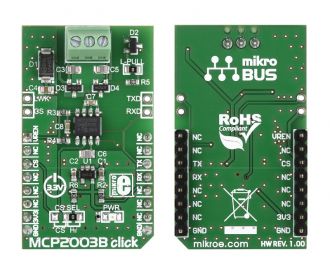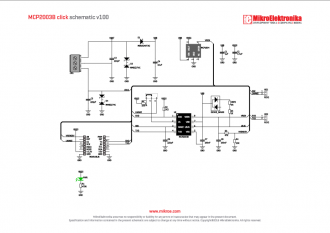
We strongly encourage users to use Package manager for sharing their code on Libstock website, because it boosts your efficiency and leaves the end user with no room for error. [more info]

Rating:
Author: MIKROE
Last Updated: 2016-10-25
Package Version: 1.0.0.0
Category: LIN
Downloaded: 2444 times
Not followed.
License: MIT license
MCP2003B click is a mikroBUS add-on board with a bi-directional LIN transceiver.
The click has three onboard screw terminals for connecting the transceiver to a LIN network (three wires: LIN, VBB and GND). MCP2003B click communicates with the target board MCU through the mikroBUS UART interface (RXD, TXD).
Do you want to subscribe in order to receive notifications regarding "MCP2003B Click library" changes.
Do you want to unsubscribe in order to stop receiving notifications regarding "MCP2003B Click library" changes.
Do you want to report abuse regarding "MCP2003B Click library".
| DOWNLOAD LINK | RELATED COMPILER | CONTAINS |
|---|---|---|
| 1469024986_mcp2003b_click_l_mikroc_arm.zip [15.75KB] | mikroC PRO for ARM |
|
| 1469025007_mcp2003b_click_l_mikroc_ft90x.zip [8.50KB] | mikroC PRO for FT90x |
|
| 1469025031_mcp2003b_click_l_mikroc_pic32.zip [9.85KB] | mikroC PRO for PIC32 |
|

MCP2003B click is a mikroBUS add-on board with a bi-directional LIN transceiver. It’s a physical interface to automotive and industrial LIN systems, in accordance to the LIN Bus Specifications Revision 2.2, SAE J2602 and ISO 17987. This standard requires that all nodes in the system are to be connected through a LIN bus. Up to 15 slave devices can be connected to a single master. The click has three onboard screw terminals for connecting the transceiver to a LIN network (three wires: LIN, VBB and GND). MCP2003B click communicates with the target board MCU through the mikroBUS UART interface (RXD, TXD), with additional functionality provided by the VRENDIV and LWAKE pins. Extra pins for LWAKE, CS, and TX and RX are also available above the mikroBUS. The board is designed to use a 3.3V power supply only.
